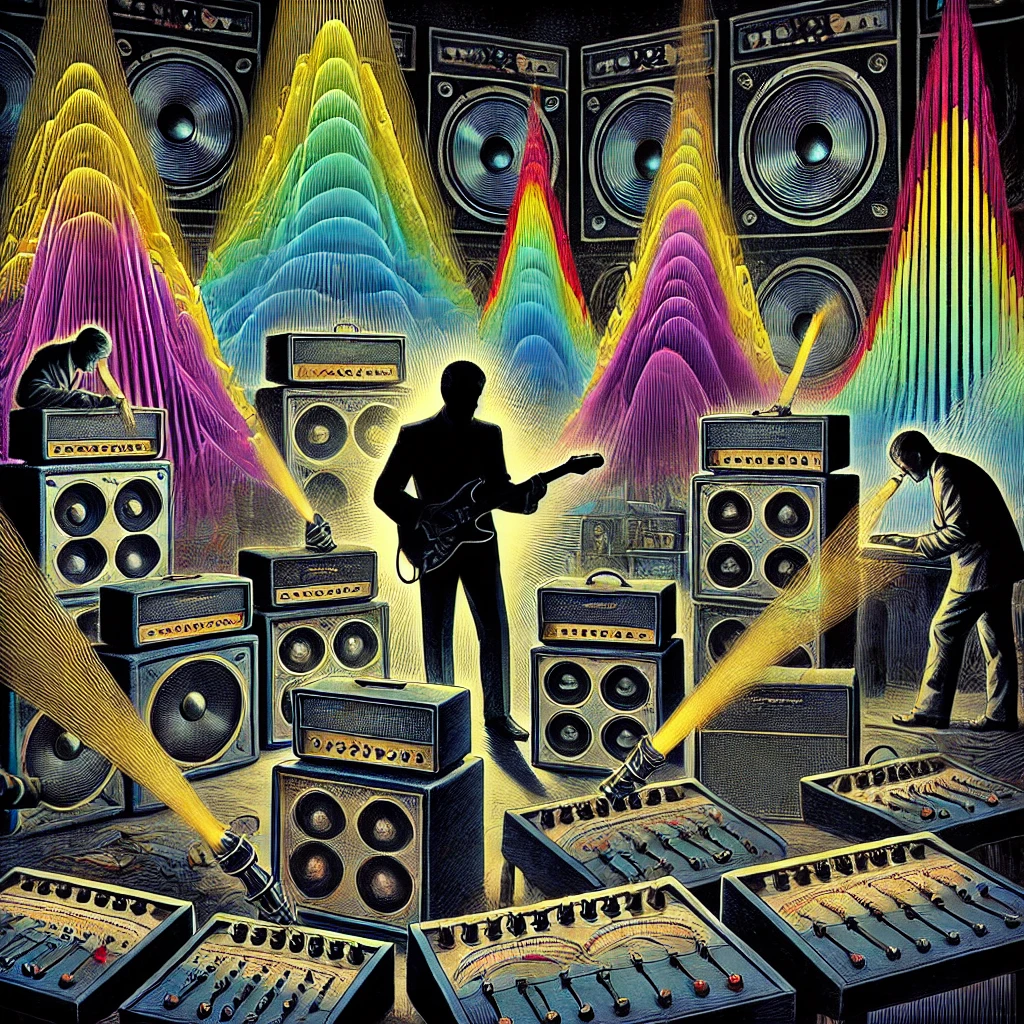Fallacy of Limited Bandwidth in Guitar Amplification
Malcolm Moore explains why limitations are not preferable
“For a guitar, the audio spectrum needs are wide. …The lower open E string has a fundamental of about 128 Hz, and significant harmonics are the second, fourth, sixth and eighth meaning the spectrum here extends to 1024 Hz. On the twelfth fret on the upper E string the fundamental is about 1,024 Hz, and the spectrum extends to about 8.192 kHz. On the 21st fret the fundamental at C# is about 1,722 Hz, and the spectrum extends to almost 14 kHz! The…frequency response needs to be virtually flat from less than 100 Hz to greater than 14 kHz to faithfully reproduce the vibrations from the guitar strings – before anybody starts to play with the audio spectrum, develop distortion, or introduce echo and / or reverberation.”
http://www.moore.org.au/pick/01/01_strt .htm
At the same time, a 12-inch speaker is probably not reproducing anything over 5 kHz.
At the same time, the “bright” switches common on many amps significantly boost the high frequency response, apparently in attempt to bring-up the highs in the final output – and undo the loss from the speaker and even perhaps the amp…which most likely leads to all kinds of zany weird distortions in the higher frequencies. Some people love that, some don’t, and there’s so many different kinds of speakers, perhaps thousands. And maybe that many amps. And tubes. And guitars. And strings. And pickups! And players.
So I think it’s fairly impossible to make any kind of sweeping statement regarding ‘limited bandwidth’ other than to explain that one purpose of GAGA is purity and clarity of tone, and we feel that begins with more faithfully amplifying whatever signal is put in, not in creating some kind of subjective-to-us, inescapable bandwidth-limiting filter/amp. There apparently are plenty of those already, and just because that’s been done for decades (a) doesn’t make it right or better, and (b) definitely means we don’t want to ‘me-too’ that. (I can’t recall a single GAGA player who’s ever complained about too much high-end.) Meanwhile, so many guitar books and mavens advise to start with the best possible clean tone – it’s the only sane starting point. Everything and anything else can then be added and/or taken away from the final tone.
When we say “high-end” we don’t say (or mean) “hi-fi” as in a dry, 2D, direct-into-mixing-board, lifeless tone. Instead, we refer more to the quality of build, design considerations, etc.
The notion of “limited bandwidth” in guitar amplification refers to the idea that certain frequency ranges are emphasized or attenuated in the amplification process, potentially affecting the tone and sound quality of the amplified signal. However, it’s essential to understand that this concept can be somewhat misleading or oversimplified in the context of guitar amplification. Here’s why:
1. Subjectivity of Tone: The perception of tone is highly subjective and influenced by various factors, including the characteristics of the guitar, the pickups, the amplifier, the speaker, and the playing technique. What one guitarist considers “limited bandwidth” may be perceived differently by another guitarist.
2. Frequency Response: Guitar amplifiers and speakers typically have a frequency response tailored to reproduce the characteristic tonal qualities of the instrument. While some amplifiers may emphasize certain frequency ranges (e.g., midrange for classic rock tones or bass for heavy metal), it’s less about “limited bandwidth” and more about shaping the frequency response to achieve the desired tonal characteristics.
3. Equalization: Many guitar amplifiers feature tone controls (e.g., bass, midrange, treble) or graphic equalizers that allow players to adjust the frequency response to their liking. These controls provide flexibility in shaping the tone and compensating for any perceived deficiencies in the amplifier’s frequency response.
4. Effects and Processing: Guitarists often use effects pedals and signal processing devices to further shape their tone and compensate for any perceived limitations in the amplifier’s frequency response. These devices can provide additional control over parameters such as gain, compression, modulation, and spatial effects.
5. Amplifier Design: Modern guitar amplifiers, especially high-quality tube amps, are designed to provide a wide frequency response and faithful reproduction of the instrument’s tonal characteristics. While some amplifiers may exhibit subtle variations in frequency response or harmonic distortion, these characteristics are often considered desirable by guitarists and contribute to the amplifier’s unique sound.
In conclusion, while the concept of “limited bandwidth” may have some validity in specific contexts, it’s essential to consider the broader factors that influence tone in guitar amplification. Factors such as amplifier design, speaker choice, equalization, effects processing, and playing technique all play significant roles in shaping the final tone, and the perceived limitations of bandwidth may be subjective or easily compensated for with proper setup and adjustment.
